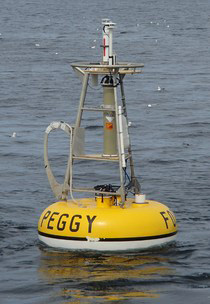Long-term Ocean Acidification Moorings

Location of Data
Real-time Data
Finalized Data
The Need

The ocean absorbs about 25% of the increasing carbon dioxide released into the atmosphere by humans, now roughly 7 million tons of CO2 every day. As a consequence, seawater is becoming more acidic. Alaska is expected to experience the effects of ocean acidification faster and more seriously than lower latitudes because waters in Alaska are both ‘cold and old’: cooler water temperatures and global circulation patterns mean that Alaska waters naturally hold more CO2 year round. On top of this high baseline concentration of CO2, other processes also naturally lower the pH of Alaskan waters on a seasonal scale. Because species can be sensitive to a change in pH, ocean acidification could impact commercial, sport, and subsistence fisheries and wildlife management.
Long time series are important to help us understand interannual variations, including influential factors such as temperature and salinity. By continuing year-round measurements (or during the ice-free season as is the case with M2), we are able to more accurately and precisely study the changes associated with ocean acidification and climate change. Better understanding these processes and documenting the observed changes will help scientists and managers prepare Alaskans for potential impacts to fisheries and livelihoods.
Project Location
- GAKOA: Mouth of Resurrection Bay near Seward (59.91N, -149.35W)
- M2: Southeastern Bering Sea (56.87N, -164.06W)

Project Details
AOOS contributes to the maintenance of two long-term moorings located in Resurrection Bay (GAKOA) and in the southern Bering Sea (M2). The buoys have a full package of oceanographic sensors which measure pCO2, pH, salinity, temperature, dissolved oxygen, and florescence.
Using these parameters, the saturation state of aragonite can be determined. Aragonite is a form of calcium carbonate that is critical to shell formation, and the aragonite saturation state provides a unit of measurement for how favorable the water is to shell-building organisms. The buoys record hourly data which is sent in near real-time to scientists at the University of Alaska Fairbanks and NOAA’s Pacific Marine Environmental Lab. Data can also be viewed through the AOOS website.
Project Highlights
Data from moorings can be paired with modeled data to help identify important natural mechanisms that can exacerbate OA. The figure at right shows direct surface measurements in the Bering Sea during the sea ice free months of April to October. The Bering Sea shelf is a wide (>600 km), relatively shallow (<100m) continental shelf with high productivity. Since the region covers the harvest grounds for the largest US fishery, understanding the habitat and changes in this region is crucial for fishery sustainability. Due to the physical characteristics of the shelf, there is high confidence in projecting modeled data across the majority of the shelf with limited observations.
In the Gulf of Alaska, observational and modeled data from GAKOA is shown at right with data from moorings near Kodiak and in Southeast Alaska (the Kodiak and Southeast moorings were removed in 2016 due to lack of funding). Naturally acidified waters can be upwelled to the surface, where waters are already affected by anthropogenic impacts. This region also has a unique chemical signature from high freshwater inputs and glacial discharge, which exacerbates OA. This study has helped build our understanding of how OA works in Alaska. The Gulf of Alaska regional model, developed by Siedlecki et al. (2017), was fine-tuned and validated with observations from the moorings. Models are an important tool that will help project how OA will impact this region in the future.
In the Gulf of Alaska, observational and modeled data from GAKOA is shown at right with data from moorings near Kodiak and in Southeast Alaska (the Kodiak and Southeast moorings were removed in 2016 due to lack of funding). Naturally acidified waters can be upwelled to the surface, where waters are already affected by anthropogenic impacts. This region also has a unique chemical signature from high freshwater inputs and glacial discharge, which exacerbates OA. This study has helped build our understanding of how OA works in Alaska. The Gulf of Alaska regional model, developed by Siedlecki et al. (2017), was fine-tuned and validated with observations from the moorings. Models are an important tool that will help project how OA will impact this region in the future.

Funding Sources & Partners
The mooring program in Alaska has been developed through a consortium of agencies including the National Science Foundation, NOAA, the North Pacific Research Board, and AOOS, and is the centerpiece of the research program within the Ocean Acidification Research Center at UAF.
Resources
Principal Investigators

UAF Ocean Acidification Research Center

NOAA PMEL

